|
Related FAQs: TWA
Invertebrates, Fishes of the Tropical
West Atlantic, Tropical West Atlantic
2,
Related Articles: Algae, Vascular
Plants, Introduction to
Fishwatcher's Guide Series Pieces/Sections, Lachnolaimus maxiumus/Hogfish, Hogfishes of the Genus
Bodianus,
Invertebrates, Algae and Vascular
Plants of The Tropical West Atlantic: Bahamas to Brazil, Part
12
To: Part 1, Part 2, Part 3,
Part 4, Part
5, Part 6, Part 7, Part 8,
Part 9, Part
10, Part 11, Part 12, Part 13,
Part 14, Part
15,
|
|
| Bob Fenner |
Echinoderms
|
Crinoids: Sea Lilies, Feather Stars: Often
misidentified as brittle stars or entirely overlooked as hidden or
decorative ornaments due to their plant-like appearance,
immobile/anchored sea lilies and the related, mobile feather stars make
up the most ancient class of the phylum echinodermata, the Crinoidea
(cry-noi-day-ah).
Due to easy breakage, suspension feeding habits and shy
and retiring behavior these animals are considered challenging to keep.
Most are doomed from difficulties accumulated from the time of their
collection to delivery to your outlet. Feather stars need not be
impossible however, as you will see.
| Davidaster rubiginosa, the Golden Crinoid.
7-10 inches, twenty arms of variable color, found in water of
30-130 foot depth. Cozumel image. Arm/pinnule close-up by
Di. |
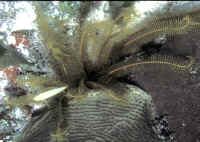 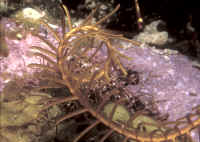
|
| Nemaster grandis, the Black & White
Crinoid. Tropical west Atlantic; southern Caribbean. Forty
arms that are darkish/black with white tips. Live completely
exposed night and day, perched on top of sponges, corals, reefs for
filter feeding. Bonaire pix. |
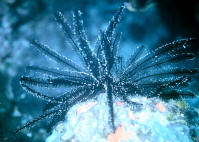
|
Sea Stars: Completely marine echinoderms of obviously overall
pentaramous symmetry. Live oral side down, feeding on a myriad of
sedentary invertebrates and detritus, detrital infauna.
| Consider the Reticulated Seastar (Oreaster
reticulatus), a large starfish common in the Turtle grass beds
of the tropical west Atlantic. Growing to twenty inches in
diameter, it consumes mollusks, even oysters in heavily calcified,
tightly shut shells, methodically and with a voracious appetite.
Like others in this fascinating Class, the Reticulated Seastar
possesses a cleverly evolved arsenal of hydraulic tube feet
connected to an elaborate water-vascular system that encircles the
animal's mouth and extends via five radial canals down the
center of each arm. Below: an Oreaster in Belize's
shallows, an individual at night off Cozumel, and an aquarium
specimen. |
| Linckia guildingi Gray 1840, the Green
Linckia. Usually with five (sometimes 4 or 6) arms that are
cylindrical in cross section. Skin appears smooth but is coarse
with low, hard nodules. Though called "green" occurs in
other colors (tan, beige, brown, blue, reddish). Big Island Hawaii
pix. |
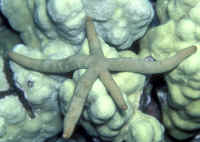 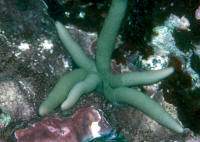
|
Brittle/Serpent and Basket Stars. The Brittle or Serpent
Stars are grouped as the Class Ophiuroidea, characterized by having
highly mobile arms that can be used to assist in (relatively) rapid
motion. These starfish-like echinoderms are decidedly quicker and more
delicate than asteroids. Their common name is derived from their
sinuous, snake-like movements, and the fact that they're truly
brittle and break away easily if they come under attack. The podia in
this class are generally used as sensory organs, rather than for active
feeding as with their kin, the asteroids. There are more than 2,000
described species worldwide, and they're found congregating
throughout shallow reef environments, hiding under rocks and within and
between other living organisms.
| Ophiocoma paucigranulata, the Spiny Brittle
Star. Tropical West Atlantic. 4-6 inches in diameter. Have pale
colored arms in their middles. Found in association with living
corals. Cozumel image at night. |
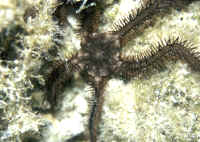
|
| Ophiothrix suensonii, the Sponge Brittle
Star. Tropical West Atlantic. 2 1/2- 3 1/2". Live principally
on sponges. Also found on fire coral and gorgonians. Arms bear a
dark line running down their mid-line. Cozumel pix. |
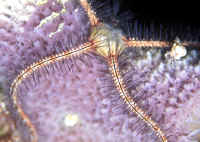
|
Basket Stars:
One fast mention of the bizarre Basket Stars. Though some folks have
reported reasonable success in their husbandry (see references below),
these nocturnal animals are by no means easy to keep in captive
conditions. They require specialized, large facilities, and diligence
in their food preparation and administration.
|
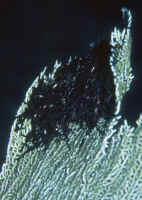
|
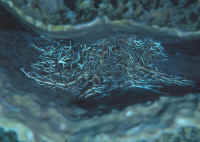
|
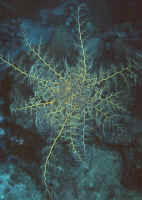
|
| The Basket Star Astrophyton
muricatum in the Bahamas. Here "sleeping" by day on a
gorgonian. |
The same species in a typical
daytime spot; curled up inside a brown sponge. This one in
Belize. |
Night time, and it's time to
unfurl your arms into the incoming current and strain out your
meal. Here in St. Lucia. |
Sea Urchins and Sand Dollars, Class Echinoidea: Friends and associates who know
me to be an avid diver frequently ask whether I'm concerned with
potential encounters with sharks, rays, giant squids and the like. My
standard reply is that hour per hour spent the
most dangerous activity we all engage in is driving on the freeway. In
all honesty, in the way of moments spent underwater, other than your
dive buddy, Sea Urchins are the most realistically harm/hurtful
organisms.
Family Diadematidae: Astropyga, Diadema,
Echinothrix.
| Astropyga magnifica, the Magnificent Urchin.
Tropical West Atlantic. To nearly ten inches in diameter counting
the spines. Deeper water (65-130 ft.) This one off St. Lucia at
night. |
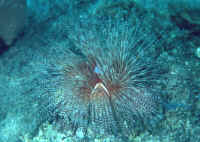
|
Family Echinometridae: Colobocentrotus,
Echinometra, Heterocentrotus.
| Echinometra lacunter, the Rock-Boring
Urchin. Dark colored with red highlights. 2-3 inches in
diameter. Relatively short, pointed spines. Tropical West
Atlantic. |
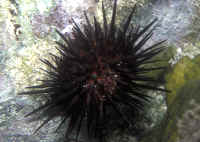
|
| Echinometra viridis, the Reef Urchin. 2-3
in. diameter. Pointed purple to brownish spines with a white ring
around their base. Tropical West Atlantic. Feed during the night
(hide in coral, rock by day) on algae. Cozumel image. |
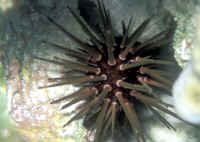
|
Family Toxopneustidae: Lytechinus, Toxopneustes,
Tripneustes.
| Lytechinus variegatus (Leske 1778), the
Variegated Urchin. Family Toxopneustidae. Tropical West Atlantic;
Bermuda to Brazil, including the Gulf of Mexico. Lives in mud to
rocky substrates. Eats algae and animal based foods. Temp.: 22-28
C. A good choice for TWA biotopic presentations. |
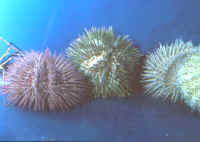
|
| Tripneustes ventricosus (Lamarck 1816), the
(West Indian) Sea Egg. Tropical East and West Atlantic coasts. Up
to eight inches in diameter. Juveniles inhabit rocks, adults moving
out to sand, grass beds. Cozumel at night and close up in the
Bahamas. |
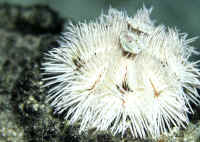 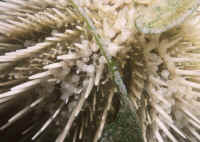
|
Family Cicaridae:
Order Spatangoida: Heart Urchins
| Meoma ventricosa, the Red Heart Urchin.
Covered with short reddish-brown spines. Tropical West Atlantic.
4-6 inches in diameter. Upperside bears a pentagonal petal design.
Here is the under and upper side to a test (dead exoskeleton) found
scuba diving off Cozumel. |
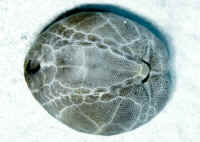 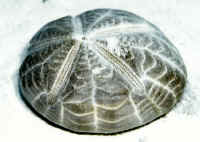
|
Order Clypeasteroida: Sand Dollars
| Clypeaster subdepressus, the Sand Dollar.
Filter feeders that live under the sand by day, emerging at night
to feed generally. 3/4 inch diameter. Tropical West Atlantic.
Cozumel image. |

|
Sea Cucumbers, Class Holothuroidea: With body
shapes ranging from spherical to long and worm-like, bizarre rings of
tentacles circling a non-descript head-end, these slow-moving, drab to
brightly colored and marked invertebrates are well-known at least by
sight, by most aquarists.
Genus Actinopyga: "Toothed Sea
Cucumbers", named for the series of five teeth ringing their
anus.
| Actinopygia agassizii, the Five-Toothed Sea
Cucumber. Have five square teeth surrounding the anus. Short,
knobby podia on back, sides. Brown to yellow on top, lighter
colored sides. Bahamas pic. |
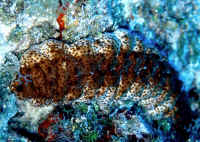
|
Genus Holothuria:
| Holothuria mexicana (Ludwig 1875), the
Donkey Dung Sea Cucumber. Tropical West Atlantic. Detritivorous.
Found singly on grass and sandy beds. To twenty inches in length.
This one in Belize. |

|
| Holothuria thomasi (Pearson 1914), the Tiger
Tail Sea Cucumber. Tropical West Atlantic, in holes, crevices,
beneath rocks. Can move quickly. To two meters in length...
stretched out. This one in the Bahamas. |
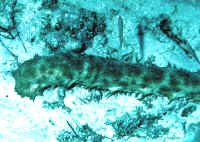 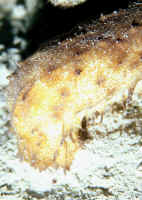
|
To: Part 1, Part
2, Part 3, Part
4, Part 5, Part
6, Part 7, Part
8, Part 9, Part
10, Part 11, Part
13, Part 14, Part
15,
|
|

